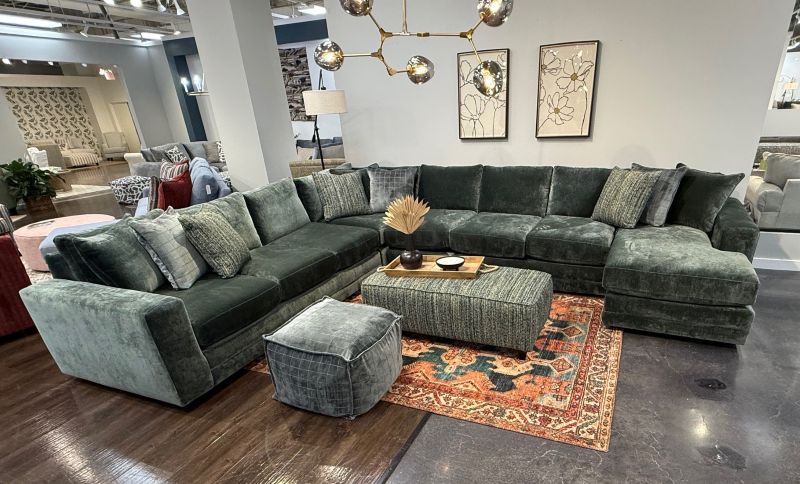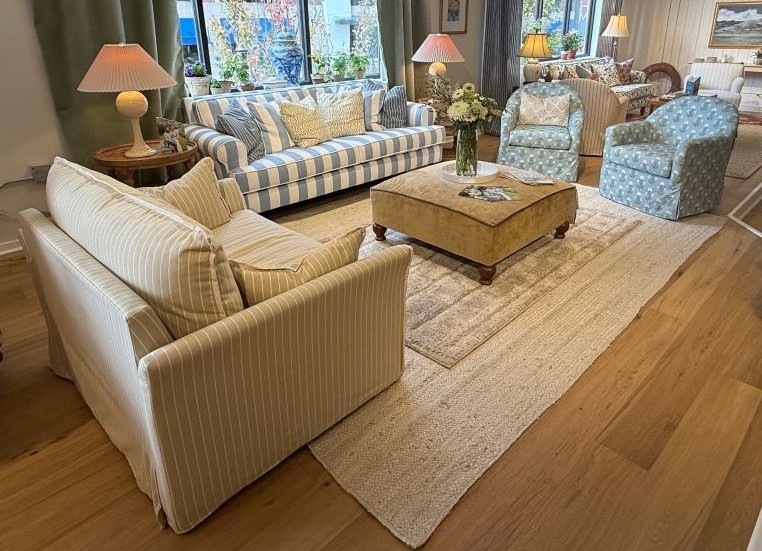Some market visitors were drawn to US manufacturers because of their largely tariff-free finished products
HIGH POINT — The reality of Section 232 tariffs on imported upholstery shifted some interest to domestic resources during the recently concluded October High Point Market.
While sources did not report a huge bump in actual orders, they said it had an impact on traffic to their showrooms at market and subsequent interest in and commitments for their product offerings.
Tariffs of 25% on four upholstery categories took effect Oct. 14, and the rate is expected to rise to 30% on Jan. 1.
The rates are not much higher than current rates on countries such as Vietnam, Malaysia, Indonesia and Thailand that range from 19% to 20%. Still, the increase has given domestic upholstery items such as sofas and loveseats an additional 10% overall price advantage compared to Vietnam and 11% compared with the other three countries.
It is among the factors that several domestic upholstery manufacturers said drove customers to their showrooms in October with some placing orders to be shipped in the coming weeks.
This is particularly true at lower-middle-to-mid-priced resources where pricing has narrowed thanks to tariffs. This is resulting in many retailers shifting their emphasis to domestic products they perceive to be higher value and more accessible as they can be produced in relatively short lead times compared with Asia.

“We have robust markets anyway, but we have a lot more appointments and I think with the values we’ve been offering, people are responding to us,” Craig Zielinski, president and chief executive officer at Albany Industries, told Home News Now at market.
At market it showed 54 new frames, some 85% of which is stationary produced in the U.S., with the balance being motion.
“We are predominantly stationary, but we do an import program as well,” Zielinski added of the higher-end import motion.
Mark Weber, president and chief executive officer at Southern Motion, told Home News Now at market that the company had good traffic thanks to its strong position as a domestic manufacturer.

“We make our product in Mississippi, and we are getting additional placements from that,” he said, noting that the company also does its cut-and-sew operations in Mississippi using domestic fabrics from STI/Revolution.
He noted that because of imported components such as fabrics, along with mechanisms and motors for its motion product line, it is not totally immune to tariffs. However, he noted the rates end up having a lesser impact on the overall cost of its finished goods since it is producing the vast majority of its product domestically.
“We have tried to stay aggressive and that has been well received on the opening price points,” he said, noting that these range from about $699 to $799 for a stationary sofa. “We had good interest in all price points in stationary. People were just looking to fill gaps and also were looking for what’s trending color-wise. We introduced a little more color. So instead of neutrals — greens and blues across the board — will be trending versus browns and tans.”

He also noted that the company saw equal interest in both stationary and motion, including some of its imported products. On the stationary side, it showed four new frames and 26 new cover packages. It also showed six new motion groups and five new recliners also shown with some new cover combinations.
“There are certain categories that people could flow cans on, but if they could get it at a value out of the warehouse and mix it with all our domestic product on a truck, they will get it quicker and cheaper,” Weber added. “So we had a good reaction on all categories — stationary, motion and import.”
Domestic resources at upper-middle price points also reported strong interest at market.

Tim Newlin, president of Norwalk Furniture, said that the company had strong attendance from existing customers and new prospects drawn to the depth and breadth of its domestic upholstery mix. In addition to new pieces in its Studio 1902 collection, it also showcased new fabrics that are part of its Crypton Home Fabrics collection with Designer Kim Salmela along with several new stationary and motion upholstery frames in its Norwalk product mix.
Customer interest and demand for these, along with inline products, was strong at the October market.
“They keep building and adding more to the assortment,” Newlin told Home News Now. “Made in the U.S. is a factor, and we are ready to ship in 35 days for custom. So the message right now is that you don’t have to carry a lot of inventory. You have the floor models and we are going to ship custom orders that fast. … It just makes our model something that you don’t have to worry about.”
This harkens back to the pandemic when retailers ordered excess imported product to fuel demand during that period. However, when demand eased, it took many months for retailers to sell through that product. The pricing of those imported goods also was impacted by high container rates during that period.
Thus, domestic resources that can produce custom orders or ship through their own domestic inventory, helps limit the amount of goods that retailers have to carry in their own warehouses.
At market, Best Home Furnishings also saw high demand levels for its domestically produced upholstery, including its new licensed upholstery collection with Erin & Ben Napier. Featuring a mix of sofas, chairs, ottomans and accent pieces, the collection is available in 85 hand-selected fabrics featuring stripes and nostalgic florals and a mix of colorful heirloom-inspired prints.

While many visitors were interested in the new licensed line, they also were there to support the company’s made-in-U.S. business model.

“We definitely have seen an increase in prospects coming in, some that we have never had contact with before, including majors,” said Eric Vollmer, senior marketing strategist, noting that the company’s domestic manufacturing footprint was a key driver of traffic. “It has been very positive, and the timing has been absolutely wonderful.”
He added while the Erin & Ben Co. line is a different stylistic approach than its initial licensed Field & Stream collection launched last fall, the reasons they are both attracting customers is the same: “Our made-in-the-USA, family-owned and -operated and custom upholstery offering is starting to finally resonate.”
To maintain its aggressive lead times for custom upholstery, he said the company aims to be creative to maintain its competitive stance in the marketplace. He said it also has invested in new fabric-cutting machinery for its Field & Stream collection, which he noted also will benefit the stripes and other patterns in the Erin & Ben Co. line.
The interest in domestic upholstery was also a driver of traffic and business at RW Collective, which earlier this year purchased the Bauhaus upholstery production facilities in Saltillo, Mississippi.

“We have so many leads right now that we are sort of at the point where we are telling people to get in right now. Because if you don’t, there is going to be a backlog,” said Rebekah Osborn, chief operating officer.
“We are going to grow and are adding another production line, but there is still a process,” she added. “The product development process is what takes the longest, and you have to get that right first before you go into production.”
She noted that customers who initially were hesitant to come on board after experiencing problems before the acquisition of Bauhaus are now ready with projects in hand after hearing positive reports in the industry. That includes the reduction of lead times from 16 weeks previously to four to six weeks currently.
“Now that we have six months under our belt and they see that our top customers are super happy, they are putting in more development with us,” she added, noting that demand is also coming from OEM customers.

Tariffs may be one factor driving customers to its domestic operations. But there are other issues, too, explained CEO Michael Carey.
“The problem with imports is that you have to be way ahead with forecasting. And then there is still the uncertainty you have with Chinese New Year and with container issues,” he said, adding that having containers held up by customs is another perceived negative impacting imports. “There are all those unknowns even without talking about tariffs.”
Sean O’Connor, president of Universal Furniture, said that the issue of tariffs has created more interest in the company’s domestic upholstery. Newer introductions in the segment also are timed to align with the move of its upholstery operations from a leased facility in Conover, North Carolina, to company production facilities in Hildebran, North Carolina later this year.

“We are moving to a bigger, better facility that is much more efficient, and with that opportunity comes the opportunity for more growth,” he said.
However, he noted that because both domestic and import upholstery lines were being developed before the tariffs went into effect, it didn’t shift the company’s emphasis to one or the other segment for this past market.
“We still support our import upholstery as much as we do our domestic, because there is a value proposition that goes with each one of them. So we are zeroing in on that.”

Rob Spilman, chairman and chief executive officer of Bassett Furniture, said the company also had very specific strategies not only with its domestic wood and upholstery, but also with its imported motion upholstery and imported wood programs.
“All those things were penciled out months ago,” he said. “I feel good about what we did, and I feel good about the reception to those products,” he said. “We have been around long enough to know what’s good and what’s bad, and we think we hit the mark. Now, we still have to deal with all the macro issues and tariffs is one of them. But I think until some other pronouncement evolves, we have already put that into the equation. … We still have to obviously provide a nice value for what we are offering.”
Bruce Cohenhour, senior vice president and chief sales officer of Bassett, said that among the company’s advantages as a domestic producer is the ability to customize its offerings, both in fabric and finish.
“We have added color back into our assortment starting last market and even before that,” he told Home News Now at the October market. “That is the first thing they (buyers) notice when they come through. So it’s not just the quality and the look and the fashion — it’s also the color. With us being able to customize it, it’s not just a sea of gray or beige out there, and our customers are really reacting to it and are putting it on the floor. Instead of the beige, they are ordering and putting color out there.”
Spilman agreed that customization is among the company’s strengths as a domestic producer and thus something that customers are responding to with commitments and written business.
But while domestic manufacturing and customization remain a key part of its strategy, Spilman also noted that it was a convergence of factors that led to its success this past market.
“The styling and the options we offer is what people now know us for and they respond to that,” he said, noting that in addition to new frames, it also curated its fabric mix this market, consolidating its grades from 16 to as low as 5 over the past six months in response to high tariffs on Chinese fabrics.
“So we had to get rid of a lot, and we added a lot. It’s been a huge amount of upheaval,” he added, noting that the work also required the company to upgrade its digital draping platform in its stores. “We have finally planted our flag with a new iteration of that. So all of this converged this market and given all of those things — plus the merchandise we brought out — it worked and we feel good about it.”
Rock House Designer Brands — which includes Century, Highland House, Hickory Chair, Hancock & Moore, Jessica Charles, Maitland-Smith and Cabot Wrenn — produces special order for most of its clients, including designers and luxury retailers. Thus, company CEO Alex Shuford III said it was not impacted by any shift in demand from import to domestic as its customers already come to Rock House for its domestic product mix.

“It was less of an issue and more background noise,” he said at the tail end of market. “Market in general was strong, and I would say pleasantly and surprisingly strong, especially in the first three and a half days. It was a little more front-loaded than normal. General attitudes of designers and retailers was that the stock market in particular is having a very positive effect on their customers’ willingness to spend money. That positive wealth effect is a real amplifier to them being busy in the last eight weeks in particular. Retailers were coming in looking for newness and in part because they want their customer to not be thinking about what the price used to be on that item. It is just easier to have a new item at the one-and-only price. It has never been anything but that.”
And on a closing note regarding tariffs, which he estimated were just 10% of the discussion at October market, he added, “I think people believe it’s just going to calm down from a volatility standpoint, which would be incredibly positive. Customers are ready to move on, and if we can keep the stock market hovering at these highs, I think that over time, it is going to overpower any of this negative noise in the background.”




